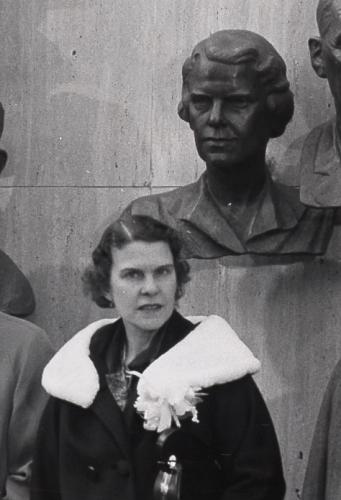
Detail of Isabel Morgan from photograph of the unveiling ceremony for the Polio Wall of Fame, 1958. Edmond Amateis papers, 1926-1977. Archives of American Art, Smithsonian Institution.
Isabel Morgan was a microbiologist who studied the development of immunity to polio viruses. While working at Johns Hopkins University in 1948, she successfully inoculated monkeys against polio using an experimental vaccine with an inactivated virus. Morgan’s research provided the essential building blocks needed to formulate the polio vaccine that Jonas Salk introduced in 1953.1
The youngest of four children born to the Nobel Prize geneticist Thomas Hunt Morgan and biologist Lilian Vaughan Sampson, Morgan grew up in the scientific communities associated with Columbia University, the California Institute of Technology, and the Woods Hole Marine Biological Laboratory in Massachusetts. Morgan was the only one of her siblings to follow her parents and make a career in research science. It was a challenging path for women who rarely enjoyed the same respect and compensation as men working in science. Nevertheless, Morgan excelled. She graduated from Stanford University, earned a master’s degree from Cornell University, and completed her Ph.D. at the University of Pennsylvania. Morgan took a position at the Rockerfeller Institute for Medical Research in New York in 1938 where she researched immunity to encephalomyelitis and poliomyelitis, most often known as polio.
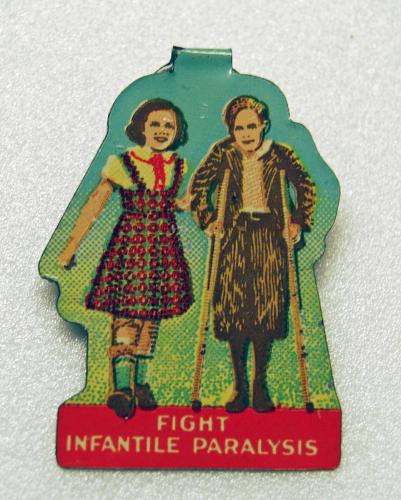
“Fight Infantile Paralysis,” March of Dimes button from 1941. Division of Medicine and Science, National Museum of American History, Smithsonian Institution.
Cases of polio had been increasing in the United States and Europe since the beginning of the twentieth century. Children and teens were especially vulnerable, but adults could also be infected. In severe cases, symptoms often appeared suddenly with the disease quickly progressing to paralysis and death. Infection rates accelerated after World War II, making the need for a vaccine more urgent.
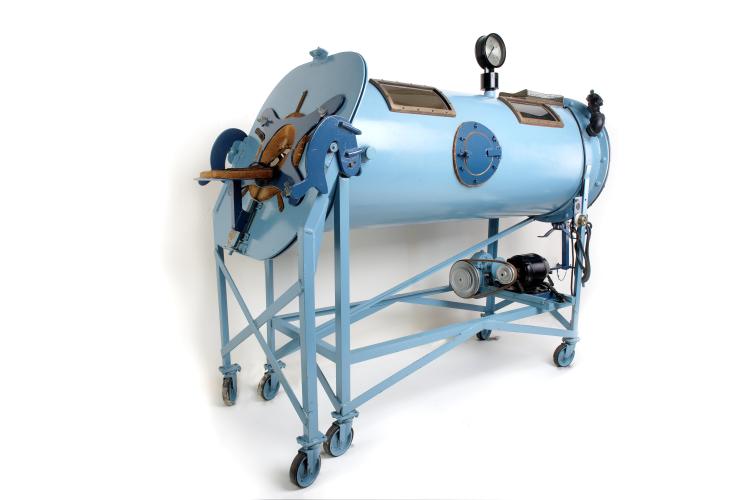
Emerson Iron Lung machine used to keep polio patients alive from 1931. Division of Medicine and Science, National Museum of American History, Smithsonian Institution.
In 1944, Morgan began working with David Bodian and Howard Howe at the Johns Hopkins University School of Hygiene and Public Health. As a team, they identified the three infectious poliovirus subtypes, a crucial turning point in polio research since earlier vaccines had only addressed one subtype. Morgan then created a vaccine using an inactivated virus that produced immunity in monkeys. She learned that multiple doses of the vaccine were needed to create protective immunity and that the use of an adjuvant, a substance used to enhance the performance of a vaccine, was beneficial. All were significant breakthroughs in the progress towards a polio vaccine.
Although highly respected by her peers, Morgan’s work has been obscured over time by the achievements of Jonas Salk and Albert Sabin, who produced viable vaccines for polio. Her contributions have been minimized by framing her story in terms of what Morgan might have accomplished had she not left polio vaccine research after marrying Joseph Mountain in 1949.
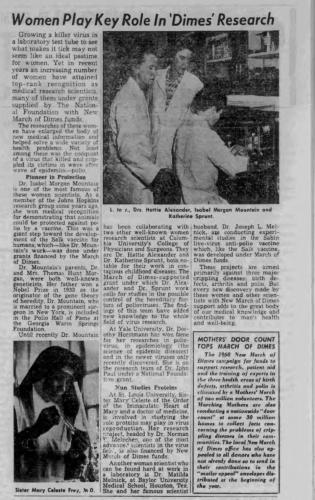
March of Dimes news story that was published in small newspapers throughout the United States in 1960. Isabel Morgan Mountain is pictured center with Dr. Hattie Alexander on her left.2
However, her career as a scientist did not end when she got married. Morgan moved to New York and continued to work in microbiology and publish articles under the name Isabel Morgan Mountain. In the 1950s, she collaborated with renowned pediatrician Hattie Alexander at Columbia-Presbyterian Medical Center. In 1958, Morgan was honored with other polio researchers with a monument erected at the Roosevelt Warm Springs Institute in Georgia. She was the only woman remembered in the monument, despite the contributions of many other women to polio research—most notably Dorothy Hortsmann at Yale University.
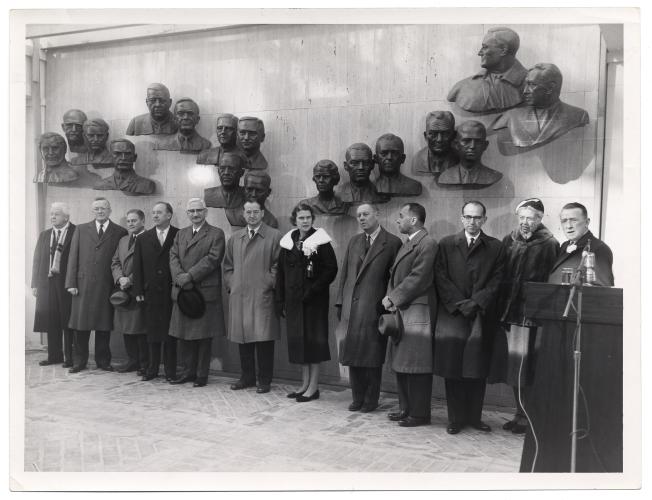
Isabel Morgan (center) stands with polio researchers honored at the Polio Wall of Fame in Warm Springs, Georgia, 1958. Edmond Amateis papers, 1926-1977. Archives of American Art, Smithsonian Institution.
In 1961, Morgan shifted her focus and spent the last two decades of her career working in biostatistics, and for many of those years she was associated with the Sloan-Kettering Cancer Institute in Manhattan. She retired in 1980. Throughout these years, she was also active in honoring her father’s legacy by maintaining her parents’ home near Woods Hole and representing the family at public events. Morgan died in 1996.
Endnotes:
1 Salk publicly announced on a national radio show that he has successfully tested a polio vaccine on March 26, 1953. Clinical trials of the vaccine took place in 1954 and a national vaccination campaign began in 1955.
2 “Women Play Key Role in ‘Dimes’ Research,” The Helper Journal, February 4, 1960, p. 6.
Further Reading:
- Rita Algorri, "Forging the Trail for Polio Vaccination: Isabel Morgan and Dorothy Horstmann," American Society for Microbiology, August 19, 2019, https://asm.org/Articles/2019/August/Forging-the-Trail-for-a-Polio-Vaccine-Isabel-Morga.
- “The Networks of Women Behind the Polio Vaccine,” Lady Science, September 17, 2020, https://web.archive.org/web/20230306141749/https://www.ladyscience.com/features/the-netowrks-of-women-behind-the-polio-vaccine.
- Anita Guerrini, "Searching for Isabel Morgan: Reconsidering the Fate of an Overlooked Polio Fighter," Science History Institute Museum & Library, June 15, 2021, https://sciencehistory.org/stories/magazine/searching-for-isabel-morgan/.
- “Preventing Polio,” National Museum of American History, Smithsonian Institution, https://americanhistory.si.edu/collections/object-groups/antibody-initiative/polio.
Related Posts
Diana Turnbow provides research and project support to the Smithsonian American Women’s History Museum.